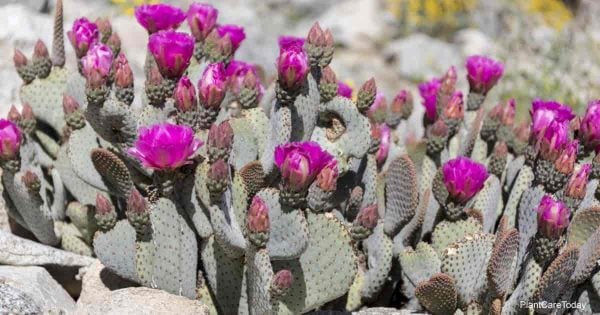Opuntia Basilaris [op-UN-tee-a, bas-il-LAIR-iss] is a small Opuntia species from the family Cactaceae (cactus).
Native to the deserts of northwest Mexico and southwestern regions of the United States, the plant is widely known for its common names:
- Beavertail cactus
- Beavertail prickly pear
Within its native range in the United States, the plant is widespread in Colorado Deserts, Anza-Borrego, Sonoran desert, and Mojave desert.
It also occurs throughout the Colorado River and Grand Canyon regions, Nevada, Utah, and Arizona’s western regions.

Several varieties of this Opuntia species, such as:
- Brachyclada
- Treleasei
- Longiareolata
… are also cultivated in various regions and are known by the scientific name of opuntia basilaris var.
Varieties such as Brachyclada have a restricted range and grow in protected areas such as Joshua Tree.
Beavertail Cactus Care
Size & Growth
Named after the ancient Greek city of Opus, this cactus species only grows up to 3” to 16” inches in height.
But, it features numerous flattened blue-gray or gray-green pads, which are spineless, fleshy, and have multiple tiny reddish-brown bristles.
Known as glochids, these bristles are sharp and pointed and can easily penetrate the skin.
Hence, you need to exercise caution while handling the plant.
Flowering and Fragrance
Prickly pear cactus produces large bell-shaped, showy wildflowers on sunken areoles from spring to early summer.
The flowers have a pink to rose or magenta-purple colors and are borne singly on the edges of the fleshy pads.
The production of edible fruit follows flowering.
Light & Temperature
Like all other cactus species, the beavertail cactus is also a sun-loving plant and needs bright and direct sunlight to grow properly.
For best growth, always plant your beavertail prickly pear in full sun.
The plant is hardy to USDA hardiness zones 8 and above and can tolerate temperatures as low as 0° degrees Fahrenheit (-18° C).
Watering and Feeding
Since the plant naturally grows in arid areas and rocky soils in its native range, it needs a very little water and is highly drought tolerant.
On average, water the newly planted plants once every two to three weeks.
Reduce watering to a minimum in winter.
The key to healthy beavertail cactus is never to let it sit in wet, soggy, poorly-drained soil.
While the cactus is planted in the ground, you do not need fertilizer. Feed the ones grown in a container with diluted water-soluble cactus fertilizer once in spring or summer.
Soil & Transplanting
For best growth and blooming, plant your opuntia basilaris in sandy, gritty, mineral-rich, alkaline, and well-draining soil with a generous amount of limestone chunks.
While the plant can tolerate some variations in the soil type, ensure it doesn’t have organic matter as it cannot tolerate organically rich soil.
Grooming and Maintenance
Opuntia Basilaris is a very low-maintenance, easy-care cactus plant.
All you need to be careful about is not to place it in the shade and make sure it gets direct sunlight.
The plant doesn’t need pruning, but the dead pads should be removed to maintain a tidy appearance.
Since the cactus can develop hundreds of pads in the right growing conditions, prune to keep it limited to a specific area or to prevent overcrowding.
How to Propagate Opuntia Basilaris
Beavertail prickly pear is propagated by seeds and plant division, but the latter is the preferred method because it is simple and always remains successful.
To grow a beavertail cactus from plan division, simply remove a pad from the plant and set it aside for a couple of days to let it develop a callus on the cut.
Then plant it in the mixture of half soil and half sand.
Opuntia Basilaris Pest or Diseases
Beavertail cactus generally remains disease and pest free.
It is also deer and rabbit resistant.
However, it attracts songbirds, hummingbirds, bees, and many other beneficial insects due to its beautiful flower color.
Beavertail Cactus Uses
Like other succulent species, beavertail prickly pear is an ideal choice for rock gardens, cacti gardens, Mediterranean gardens, and xeriscape landscapes.
It is also a good choice for growing in decks and sunny patios containers.
While the plant adds year-round interest to gardens, it particularly attracts attention during the blooming period when large, colorful flowers emerge at the tips of the pads.
In the past, the Cahuilla people, Native Americans of the inland areas of southern California, used several parts of this native plant for culinary purposes.